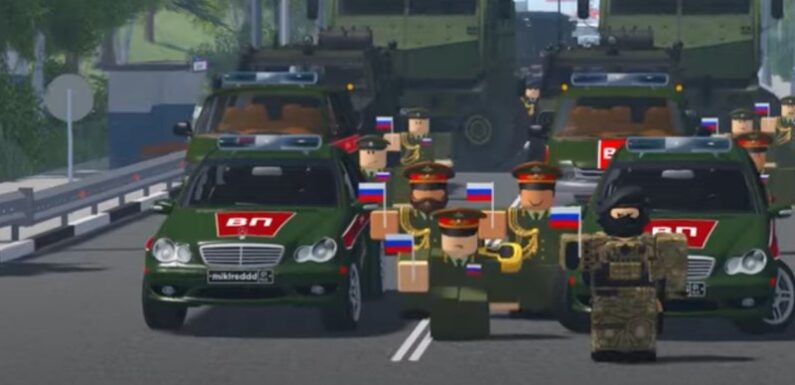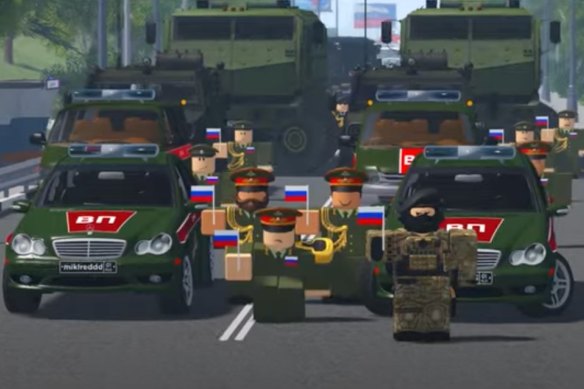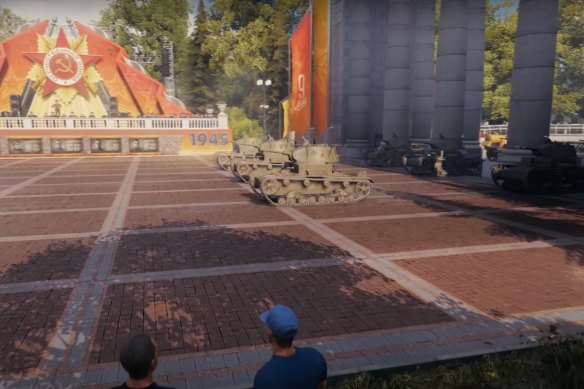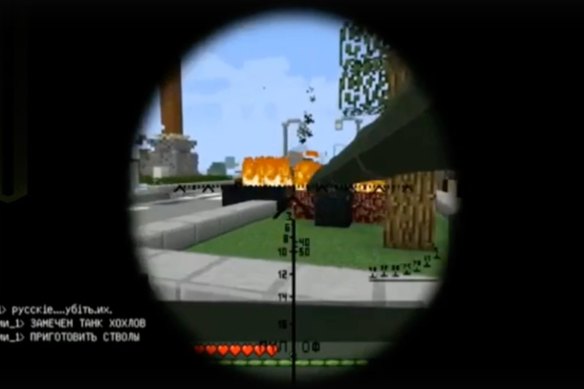
Save articles for later
Add articles to your saved list and come back to them any time.
San Francisco: Russian propaganda is spreading into the world’s video games.
In Minecraft, the immersive game owned by Microsoft, Russian players re-enacted the battle for Soledar, a city in Ukraine that Russian forces captured in January, posting a video of the game on their country’s most popular social media network, VKontakte.
A channel on World of Tanks, a multiplayer warfare game, commemorated the 78th anniversary of the defeat of Nazi Germany in May with a re-creation of the Soviet Union’s parade of tanks in Moscow in 1945. On Roblox, the popular gaming platform, a user created an array of Interior Ministry forces in June to celebrate the national holiday, Russia Day.
On Roblox, a gaming platform, a user created an array of Interior Ministry forces to celebrate Russia Day.Credit: YouTube via New York Times
These games and adjacent discussion sites such as Discord and Steam are becoming online platforms for Russian agitprop, circulating to new, mostly younger audiences a torrent of propaganda that the Kremlin has used to try to justify the war in Ukraine.
In this virtual world, players have: adopted the letter Z, a symbol of the Russian troops who invaded last year; embraced legally specious Russian territorial claims in Crimea and other places; and echoed Russian President Vladimir Putin’s efforts to denigrate Ukrainians as Nazis and blame the West for the conflict.
“Glory to Russia,” declared a video tutorial on how to construct a flagpole with a Russian flag on Minecraft. It showed a Russian flag over a cityscape labelled Luhansk, one of the Ukrainian provinces that Russia has illegally annexed.
In the Russian version of the World of Tanks video game, a recreation of the Soviet Union’s parade of tanks in Moscow in 1945. Credit: YouTube via New York Times
“The gaming world is really a platform that can impact public opinion, to reach an audience, especially young populations,” said Tanya Bekker, a researcher at ActiveFence, a cybersecurity company that identified several examples of Russian propaganda on Minecraft for The New York Times.
Microsoft’s president, Brad Smith, disclosed in April that the company’s security teams had identified recent Russian efforts “basically to penetrate some of these gaming communities”, citing examples in Minecraft and in Discord discussion groups. He said Microsoft had advised governments, which he did not name, about them, but he played down their significance.
“In truth, it’s not the No. 1 thing we should worry about,” Smith said at an economic conference in Washington organised by Semafor, the news site. “They’re going to publish information somewhere. You know, it just happens to be a good place for them to get the information into circulation.”
In Minecraft, Russian players re-enacted the battle for Soledar in Ukraine.Credit: VKontakte via The New York Times
The head of Microsoft’s threat analysis team, Clint Watts, told researchers at New York University’s Stern School of Business that the Russian paramilitary force known as the Wagner Group promoted “malign narratives” on Discord and Steam to support the Kremlin’s views. It may have also sought to encourage enlistments when Russian combat casualties were taking an enormous toll.
“The propaganda mainly seeks to make Wagner and the Russian military look cool and menacing,” Watts told the researchers, who were examining extremism in video games.
Microsoft declined to elaborate on its executives’ comments or to respond to questions about the Russian examples except to say in a statement that the company reviews content that violates its community standards.
Although some material reflects the views of ordinary Russians, other examples suggested government involvement. The Kremlin’s reach into video games shows how tenaciously Putin’s government has sought to bolster its political goals by using Western social media and consumer products despite diplomatic and economic isolation.
Yevgeny Prigozhin in a military vehicle in a street in Rostov-on-Don, Russia, in June.Credit: AP
In June, celebrities, musicians and at least one Russian government official staged a concert on Minecraft celebrating Russia Day. The official, Ekaterina Mizulina, is a member of the Civic Chamber, an advisory body, and the head of the Russian Internet Safety League. Her mother, Yelena, serves in the upper house of parliament and has been a prominent ally of Putin’s, sponsoring conservative legislation targeting, among other things, homosexuality.
Other memes appearing in games are sympathetic to the Wagner Group, which was led by Yevgeny Prigozhin until a mysterious military mutiny unravelled last month. Prigozhin, once a close ally of Putin’s, is a veteran of information operations, having founded the Internet Research Agency, the St Petersburg, Russia, company that interfered in the US presidential election in 2016.
This month, Putin underscored the Kremlin’s interest in the gaming industry as a potential tool for the government to instil values. He called it “a colossal business” in remarks to a civic organisation he founded in 2018 to focus on youth social and economic issues. One in four Russians plays games online, according to a deputy prime minister who spoke at the same meeting. Putin said games “should be at the intersection of art and education”.
“A game should help a person develop, help him find himself, should help educate a person both within the framework of universal human values and within the framework of patriotism,” Putin said in remarks in the Kremlin.
In the wake of Russia’s invasion of Ukraine in February 2022, Microsoft announced that it would suspend new sales of products and services to Russia to comply with sanctions imposed by the United States and Europe, but Russians have continued to find ways to use its games and sites such as Discord and Steam to reach broader audiences. Many of the examples are in Russian, suggesting that the intended audience is at home or among Russian speakers in neighbouring countries, including Ukraine.
“Russian propaganda is trying new things to promote its regime,” said Artem Starosiek, the head of Molfar, a Ukrainian consultancy that analyses online threats.
Molfar’s researchers identified more than a dozen instances of pro-Kremlin propaganda in Minecraft, Roblox, World of Tanks, World of Warships, Fly Corp, Armored Warfare and War Thunder. Almost all extolled the Soviet victory over Nazi Germany, a theme Putin and his advisers have used to build support for today’s war. Some of it had explicit links to political parties or government agencies.
It is not clear what steps, if any, Microsoft or other companies have taken to block Russian efforts. Wargaming Group, the Cyprus-based creator of World of Tanks and other games, spun off its Russian and Belarusian business last year to Lesta Studio, a subsidiary in St Petersburg.
Jacob Davey, head of research of far-right and hate movements at the Institute for Strategic Dialogue in London, said Minecraft and other games could be useful tools for those looking to influence vulnerable young people, especially if those people had already sorted themselves into private groups where they were eager to discuss fringe ideologies.
“We know that hostile actors who are seeking to shape minds and influence people are opportunistic,” said Davey, who has studied the gamification of extremist content online. “They go where they think they might find a receptive audience, and they adopt a wide range of tech platforms to push their messaging out.”
Given the martial nature of many games, it is not surprising that the war in Ukraine would have an influence on content, but in some cases, the games have become a battleground.
A company in Germany made a video game, Death From Above, that simulates Ukrainian drone attacks on Russian forces. The company’s owner called it “a propaganda game”. A newspaper in Finland, Helsingin Sanomat, used the video game Counter-Strike to create a conduit for factual information about the war to a Russian audience largely shielded from it.
“Could we create a place in Counter-Strike where the millions of young Russian men playing this first-person shoot game would be forced to face the terrors of the war in Ukraine?” the newspaper asked in an interactive feature.
Joseph Brown, an assistant professor at Thompson Rivers University in British Columbia, spent five years teaching about video game development in Russia, and said he had seen firsthand the country’s commitment to propaganda through video games and other forms of media.
“They need to get everybody back on board with the war,” Brown said. “It’s another piece of this whole puzzle of constant propaganda, all the time. In every single medium they can get to you with, they will get to you.”
This article originally appeared in The New York Times.
Get a note directly from our foreign correspondents on what’s making headlines around the world. Sign up for the weekly What in the World newsletter here.
Most Viewed in World
From our partners
Source: Read Full Article



